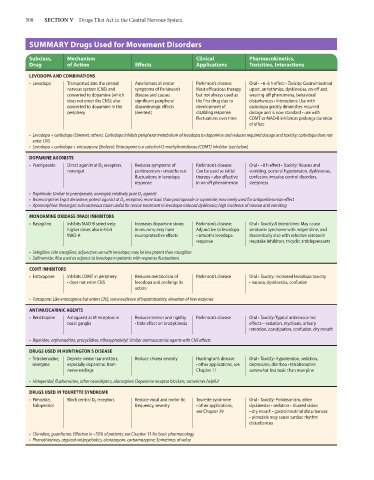Page 522 - Basic _ Clinical Pharmacology ( PDFDrive )
P. 522
508 SECTION V Drugs That Act in the Central Nervous System
SUMMARY Drugs Used for Movement Disorders
Subclass, Mechanism Clinical Pharmacokinetics,
Drug of Action Effects Applications Toxicities, Interactions
LEVODOPA AND COMBINATIONS
• Levodopa Transported into the central Ameliorates all motor Parkinson’s disease: Oral • ~6–8 h effect • Toxicity: Gastrointestinal
nervous system (CNS) and symptoms of Parkinson’s Most efficacious therapy upset, arrhythmias, dyskinesias, on-off and
converted to dopamine (which disease and causes but not always used as wearing-off phenomena, behavioral
does not enter the CNS); also significant peripheral the first drug due to disturbances • Interactions: Use with
converted to dopamine in the dopaminergic effects development of carbidopa greatly diminishes required
periphery (see text) disabling response dosage and is now standard • use with
fluctuations over time COMT or MAO-B inhibitors prolongs duration
of effect
• Levodopa + carbidopa (Sinemet, others): Carbidopa inhibits peripheral metabolism of levodopa to dopamine and reduces required dosage and toxicity; carbidopa does not
enter CNS
• Levodopa + carbidopa + entacapone (Stalevo): Entacapone is a catechol-O-methyltransferase (COMT) inhibitor (see below)
DOPAMINE AGONISTS
• Pramipexole Direct agonist at D 3 receptors, Reduces symptoms of Parkinson’s disease: Oral • ~8 h effect • Toxicity: Nausea and
nonergot parkinsonism • smooths out Can be used as initial vomiting, postural hypotension, dyskinesias,
fluctuations in levodopa therapy • also effective confusion, impulse control disorders,
response in on-off phenomenon sleepiness
• Ropinirole: Similar to pramipexole; nonergot; relatively pure D 2 agonist
• Bromocriptine: Ergot derivative; potent agonist at D 2 receptors; more toxic than pramipexole or ropinirole; now rarely used for antiparkinsonian effect
• Apomorphine: Nonergot; subcutaneous route useful for rescue treatment in levodopa-induced dyskinesia; high incidence of nausea and vomiting
MONOAMINE OXIDASE (MAO) INHIBITORS
• Rasagiline Inhibits MAO-B selectively; Increases dopamine stores Parkinson’s disease: Oral • Toxicity & interactions: May cause
higher doses also inhibit in neurons; may have Adjunctive to levodopa serotonin syndrome with meperidine, and
MAO-A neuroprotective effects • smooths levodopa theoretically also with selective serotonin
response reuptake inhibitors, tricyclic antidepressants
• Selegiline: Like rasagiline, adjunctive use with levodopa; may be less potent than rasagiline
• Safinamide: Also used as adjunct to levodopa in patients with response fluctuations
COMT INHIBITORS
• Entacapone Inhibits COMT in periphery Reduces metabolism of Parkinson’s disease Oral • Toxicity: Increased levodopa toxicity
• does not enter CNS levodopa and prolongs its • nausea, dyskinesias, confusion
action
• Tolcapone: Like entacapone but enters CNS; some evidence of hepatotoxicity, elevation of liver enzymes
ANTIMUSCARINIC AGENTS
• Benztropine Antagonist at M receptors in Reduces tremor and rigidity Parkinson’s disease Oral • Toxicity: Typical antimuscarinic
basal ganglia • little effect on bradykinesia effects—sedation, mydriasis, urinary
retention, constipation, confusion, dry mouth
• Biperiden, orphenadrine, procyclidine, trihexyphenidyl: Similar antimuscarinic agents with CNS effects
DRUGS USED IN HUNTINGTON’S DISEASE
• Tetrabenazine, Deplete amine transmitters, Reduce chorea severity Huntington’s disease Oral • Toxicity: Hypotension, sedation,
reserpine especially dopamine, from • other applications, see depression, diarrhea • tetrabenazine
nerve endings Chapter 11 somewhat less toxic than reserpine
• Haloperidol, fluphenazine, other neuroleptics, olanzapine: Dopamine receptor blockers, sometimes helpful
DRUGS USED IN TOURETTE SYNDROME
• Pimozide, Block central D 2 receptors Reduce vocal and motor tic Tourette syndrome Oral • Toxicity: Parkinsonism, other
haloperidol frequency, severity • other applications, dyskinesias • sedation • blurred vision
see Chapter 29 • dry mouth • gastrointestinal disturbances
• pimozide may cause cardiac rhythm
disturbances
• Clonidine, guanfacine: Effective in ~50% of patients; see Chapter 11 for basic pharmacology
• Phenothiazines, atypical antipsychotics, clonazepam, carbamazepine: Sometimes of value

